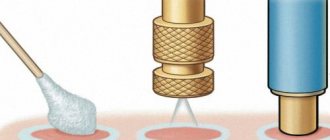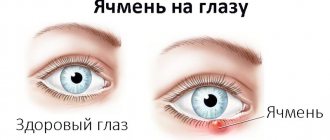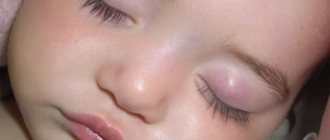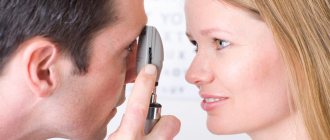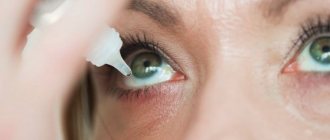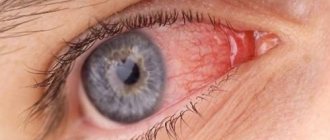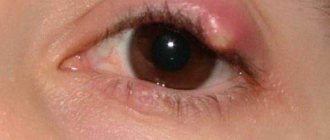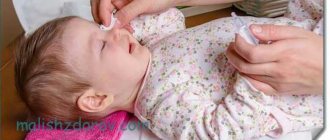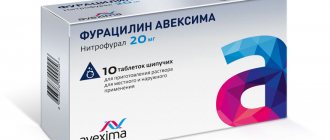Why do the upper eyelids above the eyes swell?
The simplest reason that you have puffiness above your eyes is because you drank too much fluid the day before. If the tissues around the eyes rarely swell, then there is no danger to health. If often, then it is worth undergoing a full medical examination to identify the disease.
Swelling in the upper eyelids can also be caused by other reasons, such as changes in hormonal levels in women associated with the menstrual cycle.
What can cause swelling above the eyes?
Inflammatory causes
- Barley. In this case, swelling of one upper eyelid is observed; a round formation is determined by touch. Either the right eyelid or the left one swells. It is rare for multiple styes to occur. Additional symptoms: hyperemia, i.e. redness, pain on the affected side, sometimes a moderate increase in body temperature.
- Conjunctivitis is inflammation of the conjunctiva. In this case, the eyelids may become swollen and red, lacrimation and redness of the sclera may appear.
- Purulent diseases (erysipelas, endophthalmitis). All purulent diseases are characterized by: fever (high body temperature), pain that sharply increases with palpation, lacrimation, swelling, the presence of formed pus or infiltrate.
Erysipelas is characterized by additional symptoms: hot skin over the affected area, which can become very swollen; in severe cases, the presence of gangrene and bleeding ulcers. Furunculosis is characterized by the presence of one or more boils - a round purulent formation that affects the hair follicle, sebaceous gland and surrounding connective tissue.
Endophthalmitis is severe inflammation of the internal structures of the visual organs. It is characterized by pronounced hyperemia of the sclera, blurred vision, and lacrimation.
Non-inflammatory causes
- Kidney diseases: glomerulonephritis, pyelonephritis, renal amyloidosis, renal failure. In case of kidney disease, swelling in the upper eyelids of the eyes is bilateral, pale, appears in the morning, and is soft to the touch.
- Diseases of the cardiovascular system: cardiomyopathy, cardiosclerosis, heart failure. Cardiac edema appears in the evening and goes away after rest. Thick to the touch. The color is bluish.
- Benign neoplasms on the upper eyelid: papilloma, fibroma, lipoma. Externally round (regular or slightly irregular) shape, normal color, painless.
- Malignant neoplasms: cancer of the upper or lower eyelid. In the first stages it does not manifest itself at all. It may then appear as a swelling in the corner of the eye (outer and/or inner) or in the center of the upper or lower eyelid. In later stages, many symptoms appear. From the affected organ: lacrimation and redness, pain, ulceration, bleeding. General symptoms: weakness, weight loss, pale skin, as well as symptoms associated with the appearance of metastases in other organs.
Read more about eye cancer here.
Allergic causes
- Quincke's edema (angioedema). It is characterized by the sudden appearance and rapid increase in swelling in the eye area. Additionally, the throat and tongue may become swollen. The causes are allergens that enter the body. The most common are honey, chicken protein, citrus fruits, pollen of flowering plants, preservatives, dust, and some medications.
Quincke's edema is a life-threatening condition. Requires emergency medical attention.
- Mild allergic reaction. Caused by any allergens to which a person is sensitive. At the same time, he complains that his eye itches and hurts, and his upper eyelids are swollen.
Mechanical reasons
- Drink a large amount of liquid before bed. Such swelling goes away quickly and does not last long. The upper eyelids may become swollen if you drink plenty of water at night, or if you drink too much alcohol or sweet carbonated drinks. When the cause is eliminated, the tissues do not swell.
- Injuries to the organs of vision: bruise, blow, injury, recovery period after surgery. During the initial examination, it is clear that the patient’s eyelid is very swollen and hurts. There is redness/bluishness of the skin in the area of injury. The upper eyelid hurts when blinking, touching or pressing.
- Foreign body: metal shavings, insects, large dust particles, etc. A person is bothered by lacrimation and pain in the eye. The upper eyelid is visually swollen and red.
Additionally, watch a video with a cosmetologist’s opinion about eye puffiness:
Additionally, we invite you to read the article on why your eyebrow hurts.
Causes of the disease
There can be many reasons for a swollen eyelid, the most common reason being allergies. Be it an allergy to some kind of medication or to a pet. Most often, a person experiences an allergy that causes swelling of the eyelid when inhaling any chemical vapors or plant pores in the spring.
- Sometimes allergies manifest themselves when eating foods, for example, oranges or tangerines, that is, citrus fruits. This reason is not the worst of all possible, and during this symptom, increased tearing of the eye may appear, sometimes with severe redness and greatly increased sensitivity to external irritation. As a rule, allergies go away quickly when taking antiallergic medications.
- The second most common cause of swelling of the eyelid above the eye is lack of personal hygiene. Various touches of the eye with dirty hands lead to germs getting into the lower eyelid. Microbes begin to actively multiply, and the infection becomes active. Swelling and redness appear, which may be accompanied by itching and increased temperature of the eyelid itself and the small surface around it. This is how dirty hands can lead to not the best consequences.
- Poor sleep and extreme fatigue can again lead to swelling of the eyelid under the eye, because... the vessels begin to narrow and the eyelid begins to be poorly supplied with blood, resulting in swelling. It is accompanied by only slight redness and goes away when sleep patterns are restored and sufficient rest occurs.
- Women may experience swelling of the upper eyelid due to the use of low-quality cosmetics or improper and careless application. Expired cosmetics can cause an allergic reaction, and contact of even normal cosmetics with the mucous membrane of the eyelid can cause slight swelling and mild irritation. Women may also experience irritation and swelling of the eyelid due to gynecological diseases.
- An insect bite or mechanical damage can cause not only irritation and swelling of the eyelid, but also a hematoma, which must be eliminated as quickly as possible to avoid consequences. If there is a strong impact or mechanical damage, scars may appear.
- Frequent tearfulness is also a cause for swelling of the eyelid, because along with tears, salt is released, which causes mild irritation. However, swelling due to this reason goes away after the release of tears stops.
- Some kidney pathologies or poor functioning can lead to fluid accumulation in the lower or upper eyelid area, because If you drink liquid, your kidneys may not be able to process the liquid. To avoid this, it is enough to drink an even amount of water every day, about 2-2.5 liters per day, drink alcohol very rarely and do not use dirty and hard water for drinking.
There are also reasons not only infectious, but also pathological. However, there are much fewer of them.
- Hormonal imbalance can cause mild swelling of the eyelid with slight redness; various pathologies of the heart and blood vessels also contribute to swelling of the eyelids, but other symptoms may appear along with them.
- Often, even ARVI, acute respiratory infections or influenza cause swelling of the eyelids, because... During these diseases, a person’s immunity noticeably decreases. Lack of vitamins and microelements also affects swelling and inflammation. However, after recovery from acute respiratory viral infections, acute respiratory infections or influenza, as a rule, swelling and inflammation disappear.
- Special attention should be paid to diseases such as barley. This is an acute purulent disease, which is accompanied not only by redness and swelling in the eye area, but also by quite severe pain. Barley must be eliminated as quickly as possible, otherwise there is a risk of pus spreading to other areas of the face, which can lead to quite serious consequences.
The appearance of barley may be associated with a weakened human immune system, hypothermia, some diseases of the gastrointestinal tract, and endocrine system disorders. Another risk factor is the condition of the eyelids; in particular, stye is more likely to appear if there is blepharitis or demodicosis on the eyelids.
Diagnostics
At the initial appointment, the doctor asks a number of questions: “Under what circumstances do the eyelids above the eyes swell? When can it swell - in the morning or evening? How long does it last and then does it go away? Is your eye swollen from above or below?”
There may be a situation where one eyelid is swollen. Or the upper eyelids of both eyes swell. It is important to tell this to determine the cause. The mandatory minimum of examinations includes:
- general blood analysis;
- general urine analysis;
- blood chemistry;
- electrocardiography;
- abdominal ultrasound examination.
Read more about the characteristics of symptoms in children.
What not to do?
If swelling of the eyelid of one eye occurs, it is strictly prohibited:
- Warming. Heating can provoke an increase in symptoms and active growth of cancer formations.
- Treatment with alcohol. Exposure to alcohol is dangerous because it can cause irritation and burns of the skin.
- Squeezing out ulcers. When squeezing, there is a risk of spreading infection.
- Taking antibiotics. Antimicrobial drugs can smooth out the clinical manifestations of the disease, which makes diagnosis difficult.
If the upper eyelids of the eyes are swollen, what to do?
When swelling appears above the eyes, treatment is prescribed depending on the cause and manifestations.
- Barley. One of the ointments is applied to the stye area: Tetracycline, Erythromycin, Gentamicin.
- Conjunctivitis is treated with eye drops with an antimicrobial effect: Albucid, Tobrex, Floxal.
- Purulent diseases. It is imperative to use antibacterial drugs (Ceftriaxone, Cefotaxime) both intravenously and in the form of eye ointments or drops (Tobrex, Albucid).
- Somatic diseases that secondary cause swelling of the upper eyelids require treatment from appropriate specialists. Kidney diseases are dealt with by a general practitioner and a nephrologist, heart diseases by a general practitioner and a cardiologist, and oncological diseases, depending on the malignancy, by an oncologist, ophthalmologist or dermatologist.
- For dermatitis and allergic reactions, comprehensive treatment will help relieve swelling of the upper eyelids. Enterosorbents: “Enterosgel”, “Polysorb”, “Smecta”. Antihistamines: Cetrin, Suprastin, Tavegil. Glucocorticosteroids for severe cases: Dexamethasone, Hydrocortisone. Locally it is necessary to use drops: “Dexamethasone”, “Allergodil”.
- In case of a foreign body, Visin drops will help relieve slight swelling from the upper eyelid. First you need to remove the foreign body.
- In case of injuries, after operations on the visual organ, Visin drops will help reduce swelling.
Traditional methods of treatment involve the use of herbal decoctions. At the pharmacy you can buy in filter bags such herbal remedies as “Diuretic Herbal Collection”, “Lingonberry Leaf”, “Flaxseed”. For a quick effect, you can try putting ice cubes from clean water or parsley decoction on your closed eyes.
You will learn even more effective tips and recipes from the video:
Medicines and folk remedies for swelling of the eyelid
Swollen eyelid: how to treat it - medications and folk remedies? This question is always of interest to those who are sick, but first of all it is necessary to proceed from the severity of the illness.
- If the eyelid is swollen, treatment must begin immediately. If swelling of the eyelid occurs due to colds, then antibacterial drugs should be used for treatment.
- Symptomatic treatment is used for insect bites.
- To quickly solve problems with infectious diseases, the patient can take diuretics.
Taking medications on your own without a doctor's prescription can have serious consequences.
ethnoscience
Let's consider traditional medicine methods that will help if the eyelid is swollen.
To quickly relieve or reduce swelling of the eyes, a compress with cool water can help. It should be kept on your eyes for no more than 20 minutes. You can use pieces of ice that are wrapped in cloth, otherwise you can burn the delicate skin of your eyes.
For conjunctivitis, as well as if the eyes become red with other inflammatory symptoms, use beeswax or honey, which is first diluted with water in a 1:2 ratio, like eye drops.
A decoction of chamomile can help by rinsing your eyes several times a day. Lotions and compresses made from cucumber juice and boiling water on a swollen eyelid will help relieve eye inflammation. If only one eye is inflamed, the healthy one should also be treated. Otherwise, the healthy eye will become infected.
Rinsing the eyes with a saline solution will help treat conjunctivitis. It is necessary to dilute the solution in a ratio of 1 tbsp. l. for 1 glass of boiled water.
For eye diseases, you should follow a therapeutic diet that limits the consumption of sweet, peppery, and fried foods. You should not eat foods containing starch, tomatoes, and cereals. During treatment, it is better to avoid drinking strong alcoholic drinks, tea and coffee.
It is necessary to eat fresh fruits and vegetables. Vegetables should be included in the diet, with the exception of potatoes and citrus fruits. Animal products, apples and whole grains can be consumed.
Prevention
Preventive measures:
- Limit fluid intake 2 hours before bedtime.
- Eliminate or limit alcohol consumption.
- Limit consumption of salty and sweet foods. The eyes may become swollen due to the fact that salt and glucose are osmotically active substances and are able to retain water and interfere with its excretion from the body.
- Treat diseases of the organ of vision, kidneys, and heart in a timely manner.
- Use protective masks when working in production.
- Wear sunglasses in bright sunshine.
If, despite the recommendations, your upper eyelid still regularly hurts, itches, or may become swollen, seek medical help from a specialist.
Share the article with your friends. Tell us about your experience in the comments. All the best. Be healthy.
